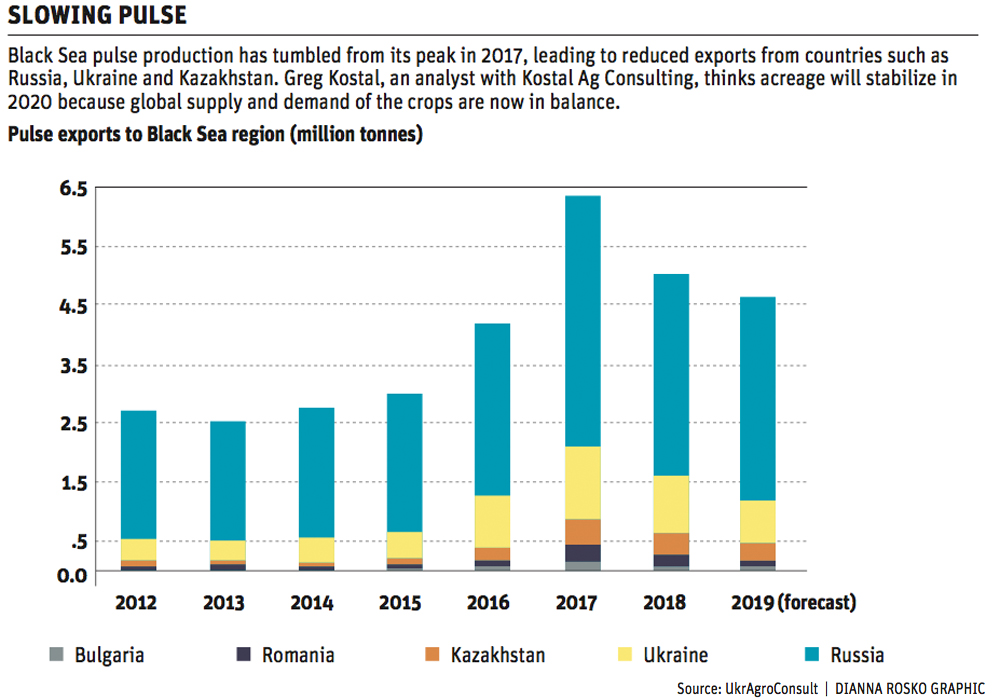The drop in production and exports is part of a global trend as the world reacts to shrinking demand in India
Canadian pulse exporters are facing vastly reduced competition from the Black Sea region this year.
Pulse production in Russia, Ukraine, Kazakhstan, Romania and Bulgaria in 2019 was about two million tonnes below its peak in 2017, according to a story published on the Global Pulse Confederation website.
The article, written by UkrAgroConsult director general Sergey Feofilov, shows how Black Sea pulse production has fared since 2012.
It used to hover around 2.5 million tonnes, began rising in 2016, peaked at close to 6.5 million tonnes in 2017 and has fallen back to slightly more than 4.5 million tonnes in 2019.
Read Also

Crop estimates show mixed results
Model-based estimates used by Statistics Canada showed the 2025/26 crop year has seen increases in canola, corn for grain, oats and lentils production while seeing dips in spring wheat, durum wheat, soybeans and barley in comparison to 2024/25.
“Everybody is just peeling back,” said Greg Kostal, analyst with Kostal Ag Consulting.
Canada’s pulse production peaked a year earlier than the Black Sea region. This year’s seven million tonne output is well off the 2016-17 high of 8.4 million tonnes.
Kostal said the pulse industry is responding to the new reality that India is no longer the ravenous importer of pulses that it was in the past.
That has had a big impact on Black Sea production and exports because of its proximity to the Indian market.
Feofilov estimates that Ukraine’s yellow pea production fell 26 percent in 2019, while lentil and chickpea output dropped about 42 percent.
Ukraine’s pea exports fell by 23 percent in the July 2019 through November 2019 period, compared to the same time frame a year earlier. The European Union is the top buyer of Ukraine’s pulses.
Russia’s peas are moving at the slowest pace of the last six years, according to Feofilov. Shipments from July 2019 through November 2019 were down 33 percent from the same period a year ago.
India has been the top buyer of Russian peas despite its punitive trade barriers, but shipments to the EU are down 68 percent.
Kazakhstan’s pea acres fell 21 percent compared to 2018, and its lentil plantings were down 69 percent.
Pea exports for that country were down 12 percent for the September 2019 through November 2019 period, while lentil exports grew by 21 percent because of strong demand from Turkey, said Feofilov.
Kostal said Russia’s pea shipments to India were happening through what he termed a “legal black market,” but that window has now closed with stricter importing rules being enforced by India.
He doesn’t think Canada will benefit from the precipitous decline in Black Sea pea shipments to the EU.
“We are just too far away to expect that to be a competitively viable type outlet,” he said.
Canada will continue to benefit from the lack of Black Sea competition into China’s pea market because of the lack of phytosanitary agreements between China and Black Sea exporters such as Russia and Ukraine.
However, China is trying to hash out agreements with those countries in order to diversify its source of supply.
Kostal believes Black Sea pulse production has bottomed out and is unlikely to decline further in 2020.
“I would anticipate stability in and around that area. I don’t think they’re going to keep dropping,” he said.
Global supply and demand in pulse markets is in better balance because exporters have curtailed production over the last few years.
















